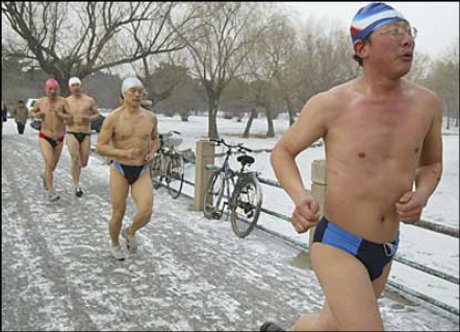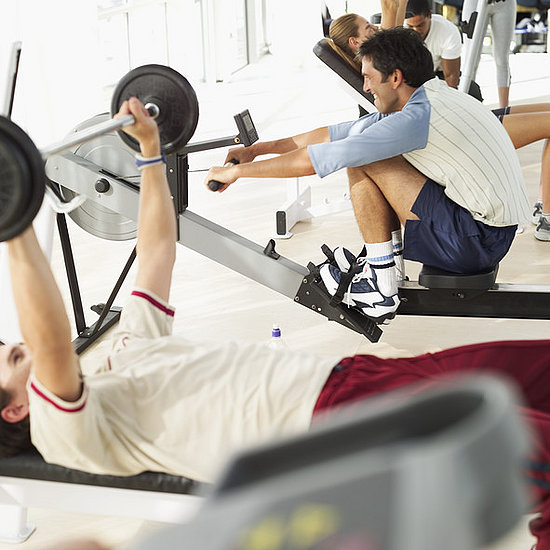
Pregnant women used to be told any exercise beyond even the most low-key, minimal exertion would endanger both their health and that of their fetus. The main concern was that the mother and fetus wouldn’t gain enough weight to produce a healthy baby come birth. It was also thought that when a pregnant woman runs, the fetus would be harmed because of less oxygen and blood flow going to the uterus. Because of fears like these, the American College of Obstetrics and Gynecology (ACOG) used to say that pregnant women shouldn’t work out strenuously for more than 15 minutes and that they should keep their heart rates below 140 beats per minute. In other words, don’t really run. A lot of faithful women runners chose to ignore those recommendations when they became pregnant. As they did, and seemed to produce normal, healthy babies, more studies were done about running and pregnancy. Among other good things, these studies found that the fears of damage to the fetus by running moms-to-be were unfounded. The pregnant body has compensatory mechanisms for decreased oxygen and blood flow to the uterus. It’s been shown that both the woman and fetus have all the fuel they need when the woman runs, even in the late stages of pregnancy, when fetal growth really takes off. Hey, Sue Olsen had to get energy somewhere during that 24-hour race, after all.
In terms of birth and after, studies have shown no real difference between sedentary pregnant women and active ones in these important matters:
➤ Complications of pregnancy, labor, and delivery
➤ Type of delivery (C-section versus vaginal)
➤ Circumference of the baby’s head
➤ Overall health of the baby
➤ Weight of the baby at birth
As for weight gain during pregnancy, one study found that active pregnant women put on about 30 pounds each, compared to 39 to 42 pounds for nonexercisers. ACOG recommends that most women gain 25 to 35 pounds.
One study compared women who worked out vigorously, including running, to those whose only exercise while pregnant was walking. When the children of these women were five years old, those of the intense exercisers scored higher on tests of intelligence, coordination, and language skills.
Because of all of this evidence that vigorous exercise is safe, ACOG revised its guidelines in 1994. Now, it encourages women who are fit and active when they become pregnant to remain so as long as they can comfortably during pregnancy. So long as you keep in close contact with your doctor and use common sense, ACOG says, it’s OK to run vigorously throughout your entire pregnancy.
Now, whether Sue Olsen’s exploits would get the ACOG seal of approval, I’m not sure. But I bet they wouldn’t have any problem with Joan Benoit Samuelson, who ran five miles on the morning before she gave birth to her second child, and remembers the
run as one of the favorites of her whole life. Remember, this is a woman who won the Olympic Marathon!
Sue and Joan are among the luckiest ones. No matter how many green lights ACOG gives you, and no matter how dedicated you are, there comes a time when intensive weight-bearing exercise like running becomes too uncomfortable to be worth doing for most pregnant women. If and when that occurs will vary from woman to woman and even from pregnancy to pregnancy for repeat moms. That’s where the common sense part of ACOG’s current guidelines come into play.
When running isn’t an option anymore, many women runners turn to less-intensive cross-training options.
When Janis Klecker, a 1992 Olympian in the marathon, was six months into her second pregnancy and pregnant with twins, running became a hindrance rather than a help. So she switched to swimming, walking, and riding a stationary bike. An Olympic teammate of hers from 1992, Gwyn Coogan, ran until the seventh month of her pregnancy, and then switched to hiking, biking, and swimming. The key is that they sensed when the running wasn’t worth doing anymore, accepted that temporary situation, and found other, more comfortable, ways to stay fit and active.







 Enter masters running. With awards given out in fiveyear brackets, you’re not forced to fight it out with the young bucks if taking home loot is part of the appeal of racing to you. Instead, it’s just you and your contemporaries, who are more likely to have the body and schedule that you do than some just-out-of-college hotshot is. The age-group categories level the playing field.
Enter masters running. With awards given out in fiveyear brackets, you’re not forced to fight it out with the young bucks if taking home loot is part of the appeal of racing to you. Instead, it’s just you and your contemporaries, who are more likely to have the body and schedule that you do than some just-out-of-college hotshot is. The age-group categories level the playing field. No matter how long you’ve been running, once you’re 40 or older, you’ll be called a masters runner. For long-time runners like me, the phrase makes a certain amount of sense—after all those years of putting in the miles, you’ve mastered how to keep at it and with enough interest that you’re still showing up at races. What’s so great about masters running? There must be something to it because I know I’m not alone in finding my running revitalized by the turning of the clock. Competition for the top prizes in the masters category are among the toughest in running. Masters running has become such a big deal that the Indianapolis Life Insurance Company sponsors a circuit of races around the country that’s open only to masters runners.
No matter how long you’ve been running, once you’re 40 or older, you’ll be called a masters runner. For long-time runners like me, the phrase makes a certain amount of sense—after all those years of putting in the miles, you’ve mastered how to keep at it and with enough interest that you’re still showing up at races. What’s so great about masters running? There must be something to it because I know I’m not alone in finding my running revitalized by the turning of the clock. Competition for the top prizes in the masters category are among the toughest in running. Masters running has become such a big deal that the Indianapolis Life Insurance Company sponsors a circuit of races around the country that’s open only to masters runners.


 The average road race is held early on a Sunday morning. A standard road race with T-shirts, awards, post-race refreshments, and so on costs $15 to $25 to enter. In other words, most people running in them have gone to bed early on a Saturday night, gotten up at least as early on a Sunday morning as on a regular workday, and then handed over the cost of a nice dinner for the opportunity to inflict pain on themselves. Sounds like they’re the idiots, huh?
The average road race is held early on a Sunday morning. A standard road race with T-shirts, awards, post-race refreshments, and so on costs $15 to $25 to enter. In other words, most people running in them have gone to bed early on a Saturday night, gotten up at least as early on a Sunday morning as on a regular workday, and then handed over the cost of a nice dinner for the opportunity to inflict pain on themselves. Sounds like they’re the idiots, huh?












 Yes and no. Yes, if you’re asking from the standpoint of “Can they run as fast?” But, more importantly, no, if you mean, “Does running affect women differently?” If the two are equally well-trained, the average woman is going to be slower than the average man, from the 100-meter dash on up to the marathon. Women have certain disadvantages when they compete against men:
Yes and no. Yes, if you’re asking from the standpoint of “Can they run as fast?” But, more importantly, no, if you mean, “Does running affect women differently?” If the two are equally well-trained, the average woman is going to be slower than the average man, from the 100-meter dash on up to the marathon. Women have certain disadvantages when they compete against men:

 Cycling has long been a favorite of cross-training runners. Besides the fact that the two exercises complement each other in developing your legs, both give you that great feeling of exercising outside. Cycling can be almost as convenient as running if you don’t live in a high-traffic area, and because you cover so much more distance, it’s a great way for runners to discover other places to enjoy their favorite sport.
Cycling has long been a favorite of cross-training runners. Besides the fact that the two exercises complement each other in developing your legs, both give you that great feeling of exercising outside. Cycling can be almost as convenient as running if you don’t live in a high-traffic area, and because you cover so much more distance, it’s a great way for runners to discover other places to enjoy their favorite sport. If I had to pick one supplementary activity that would help you the most as a runner, it would be swimming. Once you get your stroke down, swimming has many benefits: You can work hard enough to sustain a solid effort; it’s a great upper-body strengthener, it’s a nonimpact activity; and the kicking is terrific for loosening tight tendons and muscles in your feet, ankles, and legs.
If I had to pick one supplementary activity that would help you the most as a runner, it would be swimming. Once you get your stroke down, swimming has many benefits: You can work hard enough to sustain a solid effort; it’s a great upper-body strengthener, it’s a nonimpact activity; and the kicking is terrific for loosening tight tendons and muscles in your feet, ankles, and legs.



